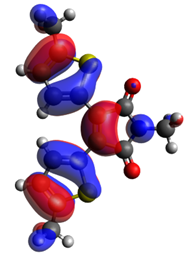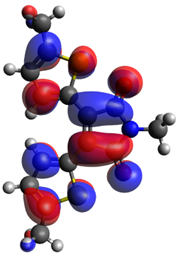In this case study, we hear from Jake Barker a Ph.D. student in Chemistry, who has been making use of BlueBEAR and the BEAR Research Data Store to enable his research into the design and synthesis of new fluorescent probes.
My name is Jake, and I am a 2nd year Ph.D. student in the O’Reilly group in the School of Chemistry. My Ph.D. project involves the design and synthesis of new fluorescent probes with the aid of computational methods. Specific-wavelength probes are desirable, as they can be designed to fit a particular niche or application. We are aiming to develop next-generation fluorophores which can be tuned to exhibit a desired photophysical profile, and computational chemistry is a key factor in this.

On a regular laptop (it) would take around 32 hours, whereas the same calculation using BEAR resources often takes less than 25 minutes
Much of my project is laboratory-based, where synthesis & analysis of photophysical properties is my main focus, but the use of TD-DFT helps me to screen, design and plan my next steps. TD-DFT is a computational method that stands for Time-Dependent Density Functional Theory. This method is the application of quantum mechanical theories, which when applied to a molecule, can be used to probe the dynamics, processes, and properties when the system is in the presence of stimuli like electric or magnetic fields. My project focuses on a class of molecules called maleimides; which are small molecules and offer facile functionalisation, with broad photophysical properties and solvent sensitivity.

A program called ORCA can be used for a variety of molecular dynamics simulations, including the electronic excitation of molecules. This method can be applied to a molecular structure, and once calculated, important properties such as wavelengths, energies, and strength of transitions can be obtained. As synthesis can be a time-consuming process, and computational calculations using BEAR (BlueBEAR) systems are comparatively rapid, potential molecules have been designed and screened before synthesis to assess their predicted properties. This method has allowed for the determination of key chemical moieties and has helped with the further rational design of maleimide derivatives. TD-DFT is an accurate method of determining these properties, with an average of 5% deviation between the predicted and experimental wavelength values.


HOMO & LUMO projections of conjugated maleimide derivatives modelled via TD-DFT
These TD-DFT calculations have allowed us to model the HOMO & LUMO of these molecules, which show the ground states of these molecules and their associated energies. Natural population analysis also shows the charge and electron populations are specific points of the molecule. These calculations and modelling are invaluable, as a deeper, mechanistic understanding of fluorescence in these molecules can be gained using TD-DFT. A standard TD-DFT calculation for a simple maleimide derivative on a regular laptop would take around 32 hours, whereas the same calculation using BEAR resources often takes less than 25 minutes, which is an incredible difference! My project focus is now shifting to the synthesis of conjugated maleimide derivatives, which include larger structures, and thus are higher complexity. These calculations would take even longer and would not be feasible to perform without some help.

By using BLUEBEAR resources, I have been able to perform over 100 calculations on a range of molecules, which has given me a greater insight and understanding into the workings of my maleimide derivatives. This process has helped inspire new synthesis, streamline my workflow, and save a lot of time from synthesising undesired molecules.
Neese, F. (2012) The ORCA program system, Wiley Interdiscip. Rev.: Comput. Mol. Sci., 2, 73-78.
We were so pleased to hear of how Jake is able to make use of what is on offer from Advanced Research Computing, particularly to hear of how he has made use of BlueBEAR HPC and BEAR RDS – if you have any examples of how it has helped your research then do get in contact with us at bearinfo@contacts.bham.ac.uk. We are always looking for good examples of use of High Performance Computing to nominate for HPC Wire Awards – see our recent winners for more details.
